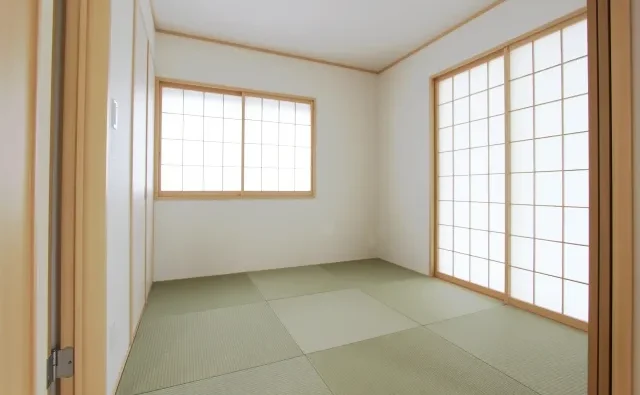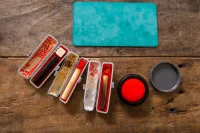How to clean tatami mats? How to remove mold and stains is also explained.

How do I clean my tatami mats?"
I want to know how to handle tatami in Japan!"
Foreigners who have started living in Japan may be surprised to see tatami, the traditional Japanese flooring. And many foreigners may not know how to handle tatami. Tatami is an indispensable part of Japanese housing, but without proper care, it can easily become damaged, moldy, and stained. In this article, we will introduce in detail what tatami is, how to care for and clean it, as well as the etiquette of tatami. This article will help you understand how to properly handle tatami.
▼Goandup Picks Click here for recommended articles!
- Required before studying abroad! Goandup Nihongo+, an online Japanese language learning service
- This page introduces services for foreigners who wish to study in Japan or improve their Japanese language skills to learn Japanese online.
- Goandup Salon" community for foreigners living in Japan
- We introduce an online community where foreigners living in Japan can exchange information and interact with each other to support their life in Japan.
- Goandup Study" supports foreigners who want to study in Japan.
- This section introduces study abroad support services that provide comprehensive support to foreigners who wish to study in Japan, from preparation for study abroad to living in Japan.
- Where can I buy a prepaid SIM in Japan? Recommended SIM cards for foreigners are also introduced.
- How to purchase a prepaid SIM and suitable SIM cards for foreigners.
- The Complete Guide to Pocket Wi-Fi in Japan for Foreigners!
- We introduce how to select and recommend pocket Wi-Fi products that can be used conveniently in Japan.
- The Complete Guide to Finding a Job in Japan! Finding a job, changing jobs, and part-time work for foreigners
- This site provides foreigners who want to work in Japan with comprehensive information on how to find a job, recommended job sites, and other information necessary to find a job.
What is tatami?

Tatami mats (tatami) are a staple of traditional Japanese rooms. When you rent a room in Japan, you may find a Japanese-style room, and tatami is always used in Japanese-style rooms. Many people may not know how to take care of tatami because they have never seen it before.
Tatami mats have been used as floors in Japan since ancient times. Tatami is made from a plant called igusa. Igusa is a tough plant with excellent durability. In addition, the size of a piece of tatami is generally twice as large horizontally as vertically. This ratio was determined in accordance with the traditional Japanese architectural style.
Tatami's ability to absorb moisture keeps you cool in summer and warm in winter. In addition, sitting on tatami is less stressful on the knees and back. Japanese people have lived on Tatami for centuries.
To learn more about tatami units and sizes, please read this article "What is the size of the unit "tatami (jou)"? The size of 6 tatami mats and tips for comfortable living.Please see the detailed explanation in the following section.
How to care for tatami

Here are some tips on how to care for tatami made of igusa. Please check carefully as proper cleaning and care are necessary to prolong the life of tatami.
Vacuum along the grain of the tatami.
Tatami mats are sewn in a certain direction. Therefore, when vacuuming, follow the grain of the tatami (in the direction of the stitching). Also, when vacuuming, it is best to spend about one minute per tatami to remove dirt well.
Do not vacuum without following the grain of the tatami (逆に from the direction it is sewn). There is a danger of damaging the tatami itself. When vacuuming, be sure to follow the lines of the tatami.
Do not wash with water
Tatami mats should not be washed with water. When caring for tatami, be sure not to wet it with water. When you want to remove stains on the surface, wipe it with a dry rag without wetting it with water.
The reason why water should not be used to clean tatami is that igusa, the raw material of tatami, is sensitive to moisture. If you wet Tatami with water, it is easy for mold to form. If you do wet the tatami with water, wipe off the moisture with a dry cloth and open a window to dry the tatami.
What to do when you stain tatami? Use salt to remove stains from tatami
Here is how to care for tatami mats when tea or food juices are spilled on them. First, absorb the water from the spilled area. Then, pour salt on the spilled area. After some time has passed and the salt has become damp, use a toothbrush to scrub along the grain of the tatami to remove the stain. Once the stain is removed, vacuum the area and you are done.
Salt is effective in removing stains from tatami because of its ability to absorb stains. However, salt can damage tatami, so care must be taken when using it. After using salt, be sure to vacuum up the salt with a vacuum cleaner.
Let's dry in the sun for mites.
Tatami mats can be infested with mites. Mites can make you feel sick or itchy. Please be assured that most mites will not occur if you clean tatami frequently. In the unlikely event that mites do occur, the tatami should be sun-dried (exposed to the sun). Mites are very sensitive to dryness, so it is important to place them in a place where they can dry. Vacuum the tatami, remove the tatami, and vacuum the back of the tatami. Then, place the tatami in a dry and sunny place. You should also vacuum the area where the tatami was removed.
Drying tatami in the sun not only prevents mites, but also removes moisture from the tatami. Regular sun-drying will keep Tatami comfortable.
How to care for mold on tatami mats
Tatami is susceptible to moisture, and mold easily grows in humid environments, such as during the rainy season. If mold has grown, it is necessary to deal with it as soon as possible.
First, vacuum the moldy area. Then, use a mold remover to remove the mold. Spray-type mold remover is convenient. Spray the mold remover, let it sit for a while, and then scrub the area with a brush to remove the mold.
After using the mold remover, be sure to wipe it off with a dry cloth and dry it thoroughly. If moisture is left on the surface, mold may grow back.
If mold has grown extensively, it is best to consult a specialist. Trying to forcibly remove the mold by yourself may damage the tatami.
Manners in a Tatami room

Here are some manners for spending time on tatami, the traditional Japanese floor. There are some points that are very different from those in a typical foreign house, so please be sure to understand them.
Do not step on the "heri" of tatami mats.
The edge surrounding the tatami is called "heri" in Japan, and is made of cloth or other material that enhances the durability of the tatami and adds to its aesthetic appeal.
In Japan, there is an old saying that heri is a place where gods live. Therefore, it is good manners not to step on the heri. Also, the heri is structurally very delicate and easily damaged. Therefore, stepping on the heri causes the tatami to be damaged at a faster rate. Be sure to observe this manner when you are in your own room or when you visit someone's house.

shoes must never step on the tatami
Japanese houses do not have a culture of going up inside the house with shoes on. In non-Japanese countries, never go up into a room with dirt feet, especially in a room with tatami mats. Tatami is easily damaged and vulnerable to humidity and water, so it should be handled with care.
When entering a Japanese house, people take off their shoes at the entrance and change into slippers. When entering a Tatami room, the slippers are also removed. It is good manners to walk on Tatami with bare feet or socks.
Serious employment support to help you realize your dream of working in Japan!

Do you want to work in Japan?
Let us "Goandup" make that dream a reality!
【 Program Features 】
✅ JLPT N3 level Japanese language acquisition
✅ Thorough preparation for the specific skills test
✅ Full support for job hunting in Japan
Business-focused one-on-one lessons will help you find a job in Japan in the shortest possible time.
【 Program Menu 】
- Individual Japanese language lessons
- Intensive curriculum to obtain N3, especially specialized lessons for business Japanese that can be used at work.
- Intensive curriculum to obtain N3, especially specialized lessons for business Japanese that can be used at work.
- Preparation for the Specific Skills Test
- Customized materials for specific skill tests will be used to focus on frequently asked questions and learning to pass the test.
- Customized materials for specific skill tests will be used to focus on frequently asked questions and learning to pass the test.
- Resume and CV support
- To create resumes and CVs tailored to Japanese corporate culture, and to brush up on self-promotion and motivation for application.
- To create resumes and CVs tailored to Japanese corporate culture, and to brush up on self-promotion and motivation for application.
- Interview Preparation
- Guidance on areas for improvement through mock interviews and feedback based on corporate interview scenarios. Learn interview etiquette and behavior unique to Japan.
- Guidance on areas for improvement through mock interviews and feedback based on corporate interview scenarios. Learn interview etiquette and behavior unique to Japan.
- career consulting
- Provide introductions to companies that match the participant's career goals, select companies to apply to, and provide advice on the level of knowledge required by the companies to which the participant is applying.
- Provide introductions to companies that match the participant's career goals, select companies to apply to, and provide advice on the level of knowledge required by the companies to which the participant is applying.
- Chat Support
- In addition to one-on-one individual lessons, we also accept casual questions via DM (visa application, living support, assistance in finding a room, etc.).
If you are serious about your career in Japan, join us now!
▶︎ for more informationclick here.
We will do our best to support your success in Japan!
summary
Proper care and cleaning of tatami, the traditional Japanese floor, is essential.
Tatami is made from a plant called igusa, which is sensitive to moisture. When cleaning, vacuum along the grain of the tatami and be careful not to wet it with water. Salt is an effective way to remove dirt from tatami. It is also important to dry the tatami in the sun regularly as a measure against mites, and if mold has grown, it is important to treat it as soon as possible with a mold remover.
As a matter of etiquette in a tatami room, do not step on the heri and do not climb up on the tatami with dirt feet. Tatami is delicate and easily damaged, so it must be handled with care. However, if you learn how to properly care for tatami and clean it frequently, you should be able to spend a comfortable and pleasant time on tatami.
Please understand the culture of Japanese housing, master how to handle tatami, and enjoy a wonderful life in Japan.
Your support will help us!
Thank you for visiting Goandup Picks. Our mission is to provide you with more useful information to show the world what Japan has to offer.
Your support will help us to further enhance our activities, so please support us!






